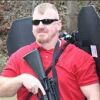Picking up from where we left off last week — if you haven’t yet read part one of this two-part series, you really should check that out before reading on — let’s look at one incident in order to fully understand the notion that in a gunfight, you need to keep firing until the bad guy is down and no longer poses a threat.
One only needs to look at the FBI’s Miami firefight involving Platt and Matix in 1986 to understand this hypothesis. Although critically wounded by a “fatal injury” in the initial exchange of gunfire, Platt was able to continue his rampage, killing agents Dove and Grogan and wounding others.
Doctors would later say that even if Platt had suffered his injury on the operating table, he still would not have been able to survive, yet he was able to fight back, and this was done without any drugs or alcohol in his system.
From this incident we learned, or at least we should have learned, that we need to shoot multiple rounds and that we need to keep shooting until the bad guy no longer poses a threat.
Although the Miami firefight happened in broad daylight, most officer involved shootings occur in low light. Even during daylight hours, officers face low light situations inside of buildings and other areas.
For this reason officers need to not only be trained in low light shooting, but in low light tactics as well. Standing on the firing line, turning your flashlight on and shooting a couple of rounds into the target just doesn’t cut it. Officers need more.
Simple things like how to move in the dark without using your flashlight need to be taught. I learned how to move in the dark back in 1977 when I was in the Army. All you have to do is pick your feet up a little higher by bringing your knees up a little higher.
It’s a little slower, but you can walk over any terrain in the dark this way without using your flashlight. Wouldn’t it be smarter to walk up on that residence where the domestic is occurring in the dark, versus giving your position away at the curb by turning your flashlight on?
When searching a building, another simple tactic to use is to turn on all of the lights. It takes the average person forty minutes for their eyes to adjust to the level of light they’re in. If you get an alarm activation in the middle of the night, who’s eyes have had more time to adjust to the dark, your eyes or the bad guy who is already in the building?
Ever play “Hide N’ Seek” as a kid? What happened when someone turned the lights on? All of a sudden your great hiding spot wasn’t so great anymore and you were forced to move, thereby making some noise or giving your position away by your movement. Any hunter will tell you it’s a lot easier to spot a deer moving in the woods versus one that’s standing still.
If you have to use your flashlight, use it sparingly. Imagine being the bad guy hiding upstairs and watching the officer’s flashlight bounce with every step he takes on the stairs. It’s not hard to figure out exactly when the officer will reach the top of the stairs if the flashlight is continuously kept on the entire time.
Turn the light on to see what you need to see and then turn it off to move, remembering to pick your feet up as you move.
Although there are no rules in a gunfight, there are simple things you can do to help prepare yourself for that fight of your life. Learn close quarter skills like point shooting, learn how to shoot while moving, and learn not only low light shooting but low light tactics as well.
Shoot multiple rounds, and above all else remember one thing: there are no rules in a gunfight!


